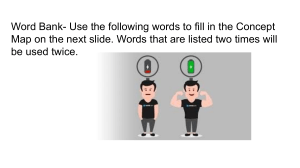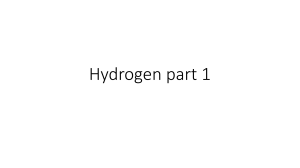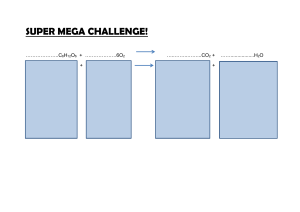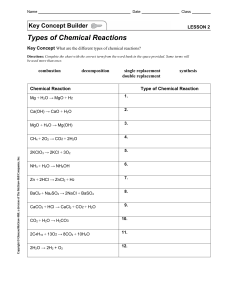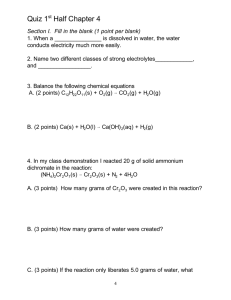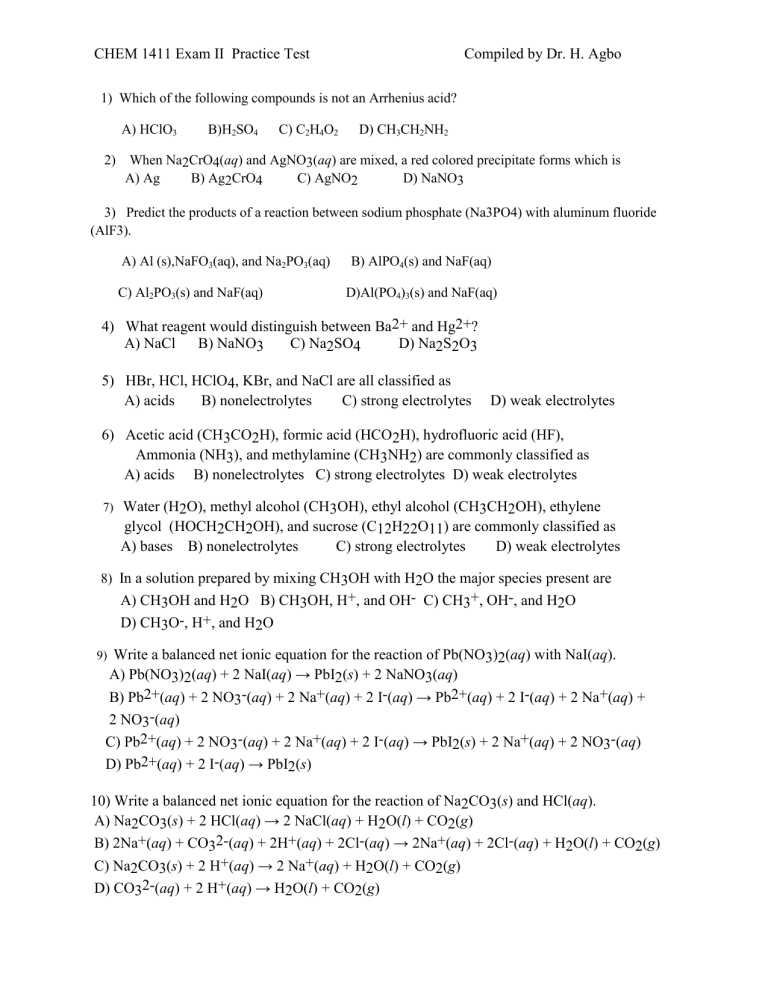
CHEM 1411 Exam II Practice Test Compiled by Dr. H. Agbo 1) Which of the following compounds is not an Arrhenius acid? A) HClO3 B)H2SO4 C) C2H4O2 D) CH3CH2NH2 2) When Na2CrO4(aq) and AgNO3(aq) are mixed, a red colored precipitate forms which is A) Ag B) Ag2CrO4 C) AgNO2 D) NaNO3 3) Predict the products of a reaction between sodium phosphate (Na3PO4) with aluminum fluoride (AlF3). A) Al (s),NaFO3(aq), and Na2PO3(aq) C) Al2PO3(s) and NaF(aq) B) AlPO4(s) and NaF(aq) D)Al(PO4)3(s) and NaF(aq) 4) What reagent would distinguish between Ba2+ and Hg2+? A) NaCl B) NaNO3 C) Na2SO4 D) Na2S2O3 5) HBr, HCl, HClO4, KBr, and NaCl are all classified as A) acids B) nonelectrolytes C) strong electrolytes D) weak electrolytes 6) Acetic acid (CH3CO2H), formic acid (HCO2H), hydrofluoric acid (HF), Ammonia (NH3), and methylamine (CH3NH2) are commonly classified as A) acids B) nonelectrolytes C) strong electrolytes D) weak electrolytes 7) Water (H2O), methyl alcohol (CH3OH), ethyl alcohol (CH3CH2OH), ethylene glycol (HOCH2CH2OH), and sucrose (C12H22O11) are commonly classified as A) bases B) nonelectrolytes C) strong electrolytes D) weak electrolytes 8) In a solution prepared by mixing CH3OH with H2O the major species present are A) CH3OH and H2O B) CH3OH, H+, and OH- C) CH3+, OH-, and H2O D) CH3O-, H+, and H2O Write a balanced net ionic equation for the reaction of Pb(NO3)2(aq) with NaI(aq). A) Pb(NO3)2(aq) + 2 NaI(aq) → PbI2(s) + 2 NaNO3(aq) B) Pb2+(aq) + 2 NO3-(aq) + 2 Na+(aq) + 2 I-(aq) → Pb2+(aq) + 2 I-(aq) + 2 Na+(aq) + 2 NO3-(aq) C) Pb2+(aq) + 2 NO3-(aq) + 2 Na+(aq) + 2 I-(aq) → PbI2(s) + 2 Na+(aq) + 2 NO3-(aq) D) Pb2+(aq) + 2 I-(aq) → PbI2(s) 9) 10) Write a balanced net ionic equation for the reaction of Na2CO3(s) and HCl(aq). A) Na2CO3(s) + 2 HCl(aq) → 2 NaCl(aq) + H2O(l) + CO2(g) B) 2Na+(aq) + CO32-(aq) + 2H+(aq) + 2Cl-(aq) → 2Na+(aq) + 2Cl-(aq) + H2O(l) + CO2(g) C) Na2CO3(s) + 2 H+(aq) → 2 Na+(aq) + H2O(l) + CO2(g) D) CO32-(aq) + 2 H+(aq) → H2O(l) + CO2(g) CHEM 1411 Exam II Practice Test Compiled by Dr. H. Agbo 11) Write a balanced net ionic equation for the reaction of CdCl2(aq) with Na2S(aq). A) CdCl2(aq) + Na2S(aq) → CdS (aq) + 2 NaCl(aq) B) Cd2+(aq) + 2 Cl-(aq) + 2 Na+(aq) + S2-(aq) → CdS(s) + 2 NaCl(aq) C) Cd2+(aq) + S2-(aq) → CdS(s) D) Cd2+(aq) + 2 Cl-(aq) + 2 Na+(aq) + S2-(aq) → CdS(s) + 2 Na+(aq) 12) Write a balanced net ionic equation for the reaction of AgNO3(aq) with Cu(s). A) AgNO3(aq) + Cu(s) → Ag(s) + CuNO3(aq) B) Ag+(aq) + Cu(s) → Ag(s) + Cu+(aq) C) 2 AgNO3(aq) + Cu(s) → 2 Ag(s) + CuNO3(aq) D) 2Ag+(aq) + Cu(s) → 2 Ag(s) + Cu2+(aq) 13) Which pair of compounds is insoluble in water? A) AgNO3 and KNO3 B) Na2S and CuS C) (NH4)2SO4 and AgI D) PbSO4 and Pb3(PO4)2 14) Which pair of compounds is soluble in water? A) AgBr and AgI B) CdS and (NH4)2S C) KI and Ba(NO3)2 D) NaNO3 and CuCO3 15) Phthalic acid is a diprotic acid having the formula HO2CC6H4CO2H that can be converted to a salt by reaction with base. Which of the following is expected to be most soluble in water? A) HO2CC6H4CO2H B) HO2CC6H4CO2Na C) HO2CC6H4CO2K D) NaO2CC6H4CO2K 16) What reagent could be used to separate Br- from NO3- when added to an aqueous solution containing both? A) AgNO3(aq) B) Ba(OH)2(aq) C) CuSO4(aq) D) NaI(aq) 17) The reaction HNO3(aq) + KOH(aq) → KNO3(aq) + H2O(l) is best classified as a(n) A) acid-base neutralization reaction B) oxidation-reduction reaction C) precipitation reaction D) single replacement reaction. 18) The reaction Cu(s) + 2 AgNO3(aq) → Cu(NO3)2(aq) + 2 Ag(s) is best classified as a(n) A) acid-base neutralization reaction B) double replacement reaction. C) oxidation-reduction reaction D) precipitation reaction CHEM 1411 Exam II Practice Test Compiled by Dr. H. Agbo 19) The combustion reaction CH4(g) + 2 O2(g) → CO2(g) + 2 H2O(l) can be classified as a(n) A) acid-base neutralization reaction B) double replacement reaction. C) oxidation-reduction reaction D) precipitation reaction. 20) What is the oxidation number change for the manganese atom in the following unbalanced reduction half reaction? MnO4-(aq) + H+(aq) → Mn2+(aq) + H2O(l) A) -7 B) -5 C) +5 D) +7 20) In which compound is the oxidation state of hydrogen not +1? A) H2O B) H2O2 C) NaH D) Na2HSO4 21) In which compound is the oxidation state of oxygen not –2? A) MgO B) Li2O C) Na2O2 D) Al2O3 22) What is the oxidation number change for the iron atom in the following reaction? 2 Fe2O3(s) + 3 C(s) → 4 Fe(s) + 3 CO2(g) A) -6 B) -3 C) +3 D) +6 23) Which species functions as the oxidizing agent in the following reduction-oxidation reaction? Zn(s) + Cu2+(aq) → Cu(s) + Zn2+(aq) A) Cu(s) B) Cu2+(aq) C) Zn(s) D) Zn2+(aq) 24) Which species functions as the oxidizing agent in the following reduction-oxidation reaction? 5 Fe2+(aq) + MnO4-(aq) + 8 H+(aq) → Mn2+(aq) + 5 Fe3+(aq) + 4 H2O(l) A) Fe2+(aq) B) H+(aq) C) Mn2+(aq) D) MnO4-(aq) 25) What is the oxidation number of the chromium atom in K2Cr2O4 ? A) -2 B) +2 C) +6 D) +7 26) What is the oxidation half reaction in the following chemical reaction? Zn(s) + 2 H+(aq) → Zn2+(aq) + H2(g) A) Zn(s) → Zn2+(aq) + 2e- B) Zn2+(aq) + 2e- → Zn(s) C) 2 H+(aq) + 2e- → H2(g) D) H2(g) → 2 H+(aq) + 2e- CHEM 1411 Exam II Practice Test Compiled by Dr. H. Agbo 27) What is the oxidation half reaction in the following chemical reaction? Cr2O72-(aq) + 6 Cl-(aq) + 14 H+(aq) → 2 Cr3+(aq) + 3 Cl2(aq) + 7 H2O(l) A) Cr2O72-(aq) + 14 H+(aq) + 6e- → 2 Cr3+(aq) + 7 H2O(l) B) Cr2O72-(aq) + 14 H+(aq) → 2 Cr3+(aq) + 7 H2O(l) + 6eC) 2 Cl-(aq) → Cl2(aq) + 2eD) Cl2(aq) + 2e- → 2 Cl-(aq) 28) What is the reduction half reaction for the following chemical reaction in a basic solution? Mn2+(aq) + 2 ClO3-(aq) + OH-(aq) → MnO2(s) + 2 ClO2(aq) + H2O(l) A) Mn2+(aq) + 4 OH-(aq) → MnO2(s) + 2 H2O(l) + 2eB) Mn2+(aq) + 2 H2O(l) → MnO2(s) + 4 H+(aq) + 2eC) ClO3-(aq) + H2O(l) + e- → ClO2(aq) + 2 OH-(aq) D) ClO3-(aq) + 2 H+(aq) + e- → ClO2(aq) + H2O(l) 29) What is the reduction half reaction for the following chemical reaction in a basic solution? ClO-(aq) + Cr(OH)4-(aq) → CrO42-(aq) + Cl-(aq A) ClO-(aq) + 2 H+(aq) + 2e- → Cl-(aq) + H2O(l) B) ClO-(aq) + H2O(l) + 2e- → Cl-(aq) + 2 OH-(aq) C) Cr(OH)4-(aq) + 4 OH-(aq) → CrO42-(aq) + 4 H2O(l) + 3eD) Cr(OH)4-(aq) → CrO42-(aq) + 4 H+(aq) + 3e30) According to the balanced chemical equation 5 H2C2O4(aq) + 2 MnO4-(aq) + 6 H+(aq) → 10 CO2(g) + 2 Mn2+(aq) + 8 H2O(l) 0.3500 grams of oxalic acid, H2C2O4 will react with ________ moles of permanganate, MnO4-. A) 0.001554 B) 0.003887 C) 0.007774 D) 0.009718 31) Molarity is defined as A) moles of solute per liter of solution B) moles of solute per liter of solvent. C) moles of solvent per liter of solution D) moles of solvent per liter of solvent 32) What is the concentration of FeCl3 in a solution prepared by dissolving 10.0 g of FeCl3 in enough water to make 275 mL of solution? A) 2.24 × 10-4 M B) 0.224 M C) 4.46 M D) 4.46 × 103 M 33) How many grams of AgNO3 are needed to make 250. mL of a solution that is 0.135 M? A) 0.0917 g B) 0.174 g C) 5.73 g D) 9.17 g CHEM 1411 Exam II Practice Test Compiled by Dr. H. Agbo 34) If the reaction of phosphate ion with water is ignored, what is the total concentration of ions in a solution prepared by dissolving 3.00 g of K3PO4 in enough water to make 350. mL of solution? A) 0.0101 M B) 0.0404 M C) 0.162 M D) 0.323 M 35) What is the concentration of HCl in the final solution when 65 mL of a 12 M HCl solution is diluted with pure water to a total volume of 0.15 L? A) 2.8 × 10-2 M B) 5.2 M C) 28 M D) 5.2 × 103 M 36) How many milliliters of a 9.0 M H2SO4 solution are needed to make 0.25 L of a 3.5 M H2SO4 solution? A) 0.097 mL B) 0.64 mL C) 97 mL D) 640 mL 37) A student prepared a stock solution by dissolving 20.0 g of KOH in enough water to make 150. mL of solution. She then took 15.0 mL of the stock solution and diluted it with enough water to make 65.0 mL of a final solution. What is the concentration of KOH for the final solution? A) 0.548 M B) 0.713 M C) 1.40 M D) 1.82 M 38) How many milliliters of 0.260 M Na2S are needed to react with 25.00 mL of 0.315 M AgNO3? Na2S(aq) + 2 AgNO3(aq) → 2 NaNO3(aq) + Ag2S(s) A) 15.1 mL B) 30.3 mL C) 41.3 mL D) 60.6 mL 39) How many grams of CaCl2 are formed when 35.00 mL of 0.00237 M Ca(OH)2 reacts with excess Cl2 gas? 2 Ca(OH)2(aq) + 2 Cl2(g) → Ca(OCl)2(aq) + CaCl2(s) + 2 H2O(l) A) 0.00460 g B) 0.00921 g C) 0.0184 g D) 0.0217 g 40) How many milliliters of 0.550 M hydriodic acid are needed to react with 25.00 mL of 0.217 M CsOH? HI(aq) + CsOH(aq) → CsI(aq) + H2O(l) A) 0.0158 mL B) 0.101 mL C) 9.86 mL D) 63.4 mL 41) In an acid-base neutralization reaction 23.74 mL of 0.500 M potassium hydroxide reacts with 50.00 mL of sulfuric acid solution. What is the concentration of the H2SO4 solution? A) 0.119 M B) 0.237 M C) 0.475 M D) 2.11 M CHEM 1411 Exam II Practice Test Compiled by Dr. H. Agbo 42) Which one of the following contains 35% carbon by mass? A) C2H2 B) CH4 C) CH3F D) CO2 43) What is the empirical formula for ethyl fluoride if the compound contains 49.97% carbon, 10.51% hydrogen, and 39.52% fluorine by mass? A) C2H5F B) C4H10F2 C) C4H10F4 D) C25F2 46) A compound responsible for the odor of garlic has a molecular weight of 146 g/mol. A 0.650 g sample of the compound contains 0.321 g of carbon, 0.044 g of hydrogen, and 0.285 g of sulfur. What is the molecular formula of the compound? A) CH5S B) C3H5S C) C3H15S3 D) C6H10S2 47) What is the stoichiometric coefficient for oxygen when the following equation is balanced using the lowest whole-number coefficients? _____ C2H6O (l) + _____ O2(g) → _____ CO2(g) + _____ H2O(l) A) 9 B) 7 C) 5 D) 3 48) What is the molar mass of fluorine gas? A) 19.0 g/mol B) 38.0 g/mol C) 6.02 × 1023 g/mol D) 1.20 × 1023 g/mol 49) How many moles are there in 3.00 g of ethanol, CH3CH2OH? A) 0. 00725 mol B) 0. 0652 mol C) 15.3 mol D) 138 mol 50) What is the mass of 8.50 x 1022 molecules of NH3? A) 0.00 829 g B) 0. 417 g C) 2. 40 g D) 121 g 51) How many moles of BCl3 are needed to produce 10.0 g of HCl(aq) in the following reaction? BCl3(g) + 3 H2O(l) → 3 HCl(aq) + B(OH)3(aq) A) 0. 0914 mol B) 0. 274 mol C) 0.823 mol D) 10.9 mol 52) How many grams of calcium chloride are needed to produce 1.50 g of potassium chloride? CaCl2(aq) + K2CO3(aq) → 2 KCl(aq) + CaCO3(aq) A) 0.896 g B) 1.12 g C) 2.23 g D) 4.47 g 53) Balance the chemical equation given below, and determine the number of moles of iodine that reacts with 30.0 g of aluminum. _____ Al(s) + _____ I2(s) → _____ Al2I6(s) A) 0.741 mol B) 1.67 mol C) 2.22 mol D) 3.33 mol CHEM 1411 Exam II Practice Test Compiled by Dr. H. Agbo 54) If the percent yield for the following reaction is 65.0%, how many grams of KClO3 are needed to produce 32.0 g of O2? 2 KClO3(s) → 2 KCl(s) + 3 O2(g) A) 53.1 g B) 81.7 g C) 126 g D) 283 g 55) 7.0 g of nitrogen is reacted with 5.0 g of hydrogen to produce ammonia according to the chemical equation shown below. Which one of the following statements is false? N2(g) + 3 H2(g) → 2 NH3(g) A) 3.5 g of hydrogen are left over B) Hydrogen is the excess reactant. C) Nitrogen is the limiting reactant D) The theoretical yield of ammonia is 15 g. 56) Which substance is the limiting reactant when 2.0 g of sulfur reacts with 3.0 g of oxygen and 4.0 g of sodium hydroxide according to the following chemical equation: 2 S(s) + 3 O2(g) + 4 NaOH(aq) → 2 Na2SO4(aq) + 2 H2O(l) A) S(s) B) O2(g) C) NaOH(aq) D) None of these substances is the limiting reactant 57) When silver nitrate (AgNO3) reacts with barium chloride (BaCl2), silver chloride (AgCl) and barium nitrate (Ba(NO3)2) are formed. How many grams of silver chloride are formed when 10.0 g of silver nitrate reacts with 15.0 g of barium chloride? A) 8.44 g B) 9.40 g C) 11.9 g D) 18.8 g 58) In the reaction between glucose and oxygen, 10.0 g of glucose reacts and 7.50 L of carbon dioxide is formed. What is the percent yield if the density of CO2 is 1.26 g/L? C6H12O6(s) + 6 O2(g) → 6 CO2(g) + 6 H2O(l) A) 26.1% B) 40.6% C) 43.1% D) 64.5% 59) Limestone (CaCO3) reacts with hydrochloric acid according to the equation CaCO3 + 2HCl CaCl2 + H2O + CO2 If 1.00 mol CO2 has a volume of 22.4 L under the reaction conditions, how many liters of gas can be formed reaction of 2.35 g of CaCO3 with 2.35 g of HCl? A) 0.526 L B) 0.645 L C) 0.400 L D) 0.750 L 60) ) How many grams of the excess reagent are left over when 6.00 g of CS2 gas react with 10.0 g of Cl2 gas in the following reaction: CS2(g) + 3 Cl2(g) → CCl4(l) + S2Cl2(l) A) 2.42 g B) 2.77 g C) 3.58 g D) 4.00 g
